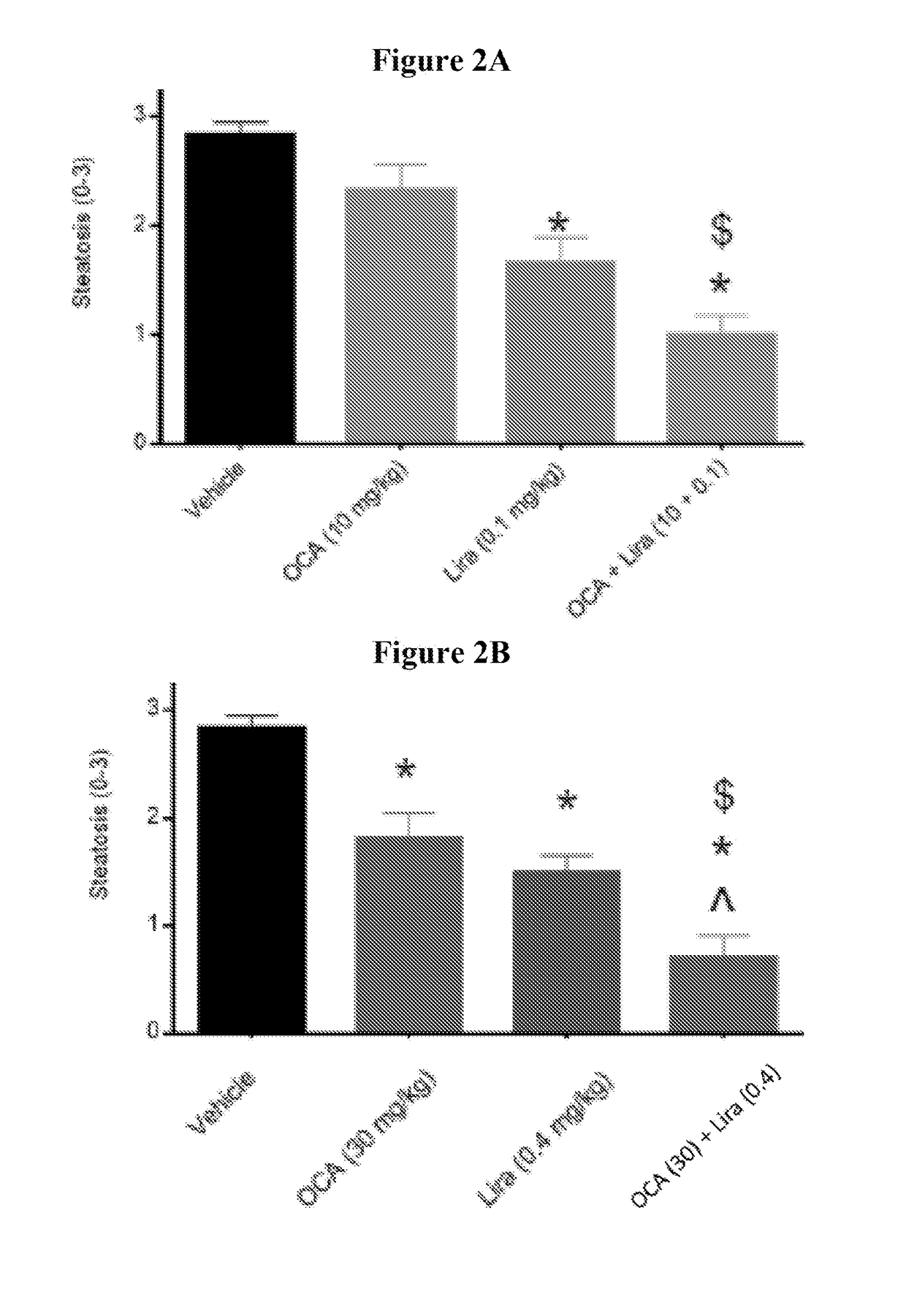Pharmaceutical compositions for combination therapy
a combination therapy and composition technology, applied in the field of combination therapy pharmaceutical compositions, can solve the problems of limited efficacy, side effects, and varied deficiencies, and achieve the effects of reducing insulin sensitivity, reducing glucose concentration, and increasing glucose concentration
- Summary
- Abstract
- Description
- Claims
- Application Information
AI Technical Summary
Benefits of technology
Problems solved by technology
Method used
Image
Examples
example 1
ced Obese NASH in C57BL / 6j Mice
[0191]The studies were conducted to evaluate the effects of obeticholic acid (OCA) and a therapeutic agent that decreases blood glucose level, stimulates insulin secretion, and / or increases insulin sensitivity, alone or in combination, on metabolic parameters, hepatic pathology, and NAS activity score in diet induced obese NASH mice. The therapeutic agents used in Examples 2, 3, and 4 were liraglutide (LIRA), metformin (MET), or sitagliptin (SIT), respectively. In one study, the anti-glycemic agent is empagliflozin (EMP). Additionally, hepatic gene expression profiling and subsequent pathway analysis were performed to determine whether the combination regulates novel genes not regulated by either monotherapy treatment, and / or more strongly regulates genes also impacted by the monotherapy.
Animals, Housing and Diet
[0192]At 5 weeks of age, male C57BL / 6 mice were purchased from JanVier, France, and transferred to the test stables. During the acclimatizati...
example 2
ced Obese NASH in C57BL / 6j Mice: Obeticholic Acid (OCA)±Liraglutide (LIRA)
[0205]The protocols and analyses for this study are provided in Example 1.
Treatment Groups
Group 1: Vehicle (PO)+Vehicle (SQ)
[0206]Mice (n=12) were administered vehicle from week 0 to 8.
Group 2: OCA (PO)+Vehicle (SQ)
[0207]Mice (n=12) were administered OCA at a dose of 10 mg / kg from week 0 to 8.
Group 3: LIRA (SQ)+Vehicle (PO)
[0208]Mice (n=12) were administered LIRA at a dose of 0.1 mg / kg from week 0 to 8.
Group 4: OCA (PO)+Vehicle (SQ)
[0209]Mice (n=12) were administered OCA at a dose of 30 mg / kg from week 0 to 8.
Group 5: LIRA (SQ)+Vehicle (PO)
[0210]Mice (n=12) were administered LIRA at a dose of 0.4 mg / kg from week 0 to 8.
Group 6: OCA (PO)+LIRA (SQ)
[0211]Mice (n=12) were administered OCA at a dose of 10 mg / kg and LIRA at a dose of 0.1 mg / kg from week 0 to 8.
Group 7: OCA (PO)+LIRA (PO)
[0212]Mice (n=12) were administered OCA at a dose of 30 mg / kg and LIRA at a dose of 0.4 mg / kg from week 0 to 8.
Group 8: Lean Chow C...
example 3
ced Obese NASH in C57BL / 6j Mice: Obeticholic Acid (OCA)±Metformin (MET)
[0221]The protocols and analyses for this study are provided in Example 1.
Treatment Groups
Group 1: Vehicle (PO)
[0222]Mice (n=11) were administered vehicle (0.5% CMC) from week 0 to 8.
Group 2: OCA (PO)+Vehicle (PO)
[0223]Mice (n=11) were administered OCA at a dose of 10 mg / kg from week 0 to 8.
Group 3: MET (PO)+Vehicle (PO)
[0224]Mice (n=12) were administered MET at a dose of 50 mg / kg from week 0 to 8.
Group 4: OCA (PO)+Vehicle (PO)
[0225]Mice (n=11) were administered OCA at a dose of 30 mg / kg from week 0 to 8.
Group 5: MET (PO)+Vehicle (PO)
[0226]Mice (n=12) were administered MET at a dose of 150 mg / kg from week 0 to 8.
Group 6: OCA (PO)+MET (PO)
[0227]Mice (n=12) were administered OCA at a dose of 10 mg / kg and MET at a dose of 50 mg / kg from week 0 to 8.
Group 7: OCA (PO)+MET (PO)
[0228]Mice (n=10) were administered OCA at a dose of 30 mg / kg and MET at a dose of 150 mg / kg from week 0 to 8.
Group 8: Lean Chow Control Group
[02...
PUM
| Property | Measurement | Unit |
|---|---|---|
| time period | aaaaa | aaaaa |
| temperature | aaaaa | aaaaa |
| concentrations | aaaaa | aaaaa |
Abstract
Description
Claims
Application Information
 Login to View More
Login to View More - R&D
- Intellectual Property
- Life Sciences
- Materials
- Tech Scout
- Unparalleled Data Quality
- Higher Quality Content
- 60% Fewer Hallucinations
Browse by: Latest US Patents, China's latest patents, Technical Efficacy Thesaurus, Application Domain, Technology Topic, Popular Technical Reports.
© 2025 PatSnap. All rights reserved.Legal|Privacy policy|Modern Slavery Act Transparency Statement|Sitemap|About US| Contact US: help@patsnap.com



